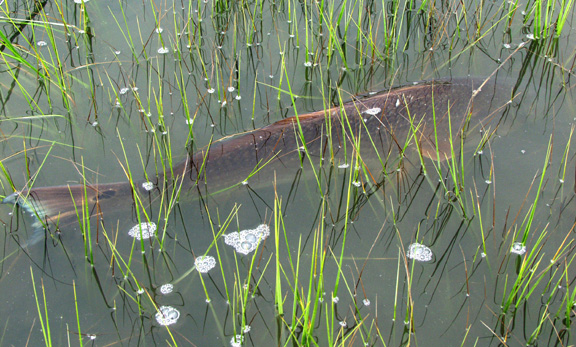


By Gordon Churchilll
From Oriental to Carolina Beach, the Intracoastal Waterway in North Carolina hosts thousands of boats on a daily basis. Most of these are cruisers out for a good time, or travelers bringing boats from one place to another. If these folks knew where to look they would find a wealth of fish holding, shallow water habitat and myriad species. The glamour fish here is the red drum.
The only real secret is figuring out what types of areas these fish frequent and what tides are best at different times of the year. Once you have those two prime bits of knowledge then the rest will come easily.
Shallow-water drum fishing in North Carolina is really in its infancy. When you travel to places like the South Carolina Lowcountry and North Florida you will see areas that look exactly like what we have along the Intracoastal Waterway. While every third person in those areas seems to have a flats skiff with a poling platform, you will go a long time before you see 10 that are registered in our state. From speaking with different guides in the Southeast who fish similar areas, we can determine what they are using, what types of habitats they are fishing and what tides they prefer. Then we have to look for those types of spots closer to home and see if they hold fish or not. Often fish will use areas only at certain stages of the tide. So if a spot looks good and you didn't see any fish at low tide try it again after it has risen.
In the colder months, red drum in the shallows will often gather in large schools. Experienced guides in South Carolina report schools containing hundreds of fish swimming in narrow creeks or across flats. Look for areas with oyster bars that stay submerged at low tide. You also want to think about areas of such low water at low tide that you could easily get stranded. This keeps boats running gill nets out! However, it does require a specialized shallow water boat for the angler. A boat that can float in less than 6 inches of water at a minimum will keep you fishing. Anything else becomes a constant exercise in trying to find enough water to float.
Winter fish are often not very hungry and are more concerned with conserving energy than chasing food. Concentrate your efforts around the low tides when it's cold. Find a school and stay on it. You may catch a good number of them. Keep working the fish in the school quietly and you may be rewarded.
The best day of redfishing I have ever had came in a creek that I could have jumped across near Jacksonville, Florida. We were about a mile back into this narrow creek that was protected by extremely shallow sandbars. This kept most boats out. We cruised along and then stopped next to the only stretch of shoreline that had an oyster bar on it. Shrimp were jumping everywhere and the water temp was 65 degrees (which is about as cold as it gets down there). We caught redfish from 27 to 32 inches for the two hours before and the two hours after low tide, and did not see another boat. Think about any areas like this that you are familiar with and check it out.
As the water warms up through the 60s and into the 70s shallow-water drum get more active and will now spread out and seek food more actively. This is the time when you can still find a good-sized school, but they will be feeding more actively and you can catch a large number of them. They will be using the same areas they used all winter. Red drum are homebodies in the shallows. If you find a school in an area, chances are those fish will never be more than a half mile from where you first found them. It is very easy to clean them out. This is why gill-netters can wipe out an area very quickly.
Catch and release has been found to be an excellent option and red drum are known to be an extremely hardy fish that can survive being caught multiple times. If you hit a school hard every day and keep every fish you are allowed to keep, it may be possible to take the majority of the fish out and not have them using that area anymore.
In the summer and early fall with water temps in the 80s is when reds can be found in extremely shallow water. Summer fish use the high tides and get into grassy areas and feed on fiddler crabs and other crustaceans that may try to hide in the mud. This is classic sight fishing and very exciting.
Summer fish will be found in water from 1 1/2 to 4 feet deep around points and oyster bars even when the water gets really hot. They will generally be feeding on baitfish and crabs.
Our inshore waters get quite murky in the summer. This can make it difficult to spot individual fish. Instead, look for waves that don't look the same as the others (called a push) and splashes made by the fish as they move quickly after something. These signs are pretty obvious once you've seen them in person.
When you spot signs of fish you need to determine what direction they are moving in and place your hook in front of them. If you are fishing bait, try a light jig head. This will allow you to make an accurate cast and lifelike presentation. If using a lure or fly move it so it looks natural to the fish.
The strike will be remarkably strong and quick. Set the hook firmly and keep a tight line. These fish know how to shake a hook. They will first try to run and then do a bulldogging back and forth type of fight. The best way to land them is with a rubberized landing net. This allows you to get the hook out quickly and get the fish back in the water. Lip landing a large drum is not recommended due to the crusher plates in the back of the throat that can hurt you if your fingers get in there.
I have tied some flies called Copperheads. The pattern was developed by a flytier and guide in Charleston named Capt Randy Hamilton. This fly is the number one producer of fish for about all the guides who are working that area. It is especially useful when the water is murky in the warmest parts of the year or in areas of soft bottom that are usually muddy.
I also have tried some bonefish jigs that I had from a recent trip to Florida. Reds are easily caught on a variety of baits. You can pin a shrimp on a jighead and cast into an area where they are feeding and almost be guaranteed of a strike. They also will hit mullet, menhaden and any variety of small baitfish and crustaceans. It doesn't matter if the bait is alive or dead. They will more than likely eat it. The challenge often lies in getting them to eat artificials. Again a large variety will work. Among the most popular are plastic bodied lures on jig heads. The same kind that work for speckled trout often work on reds. Gold spoons are an old standby and the Johnson Silver Minnow is the one used most often. The most exciting lure to use is the most underapreciated. A topwater lure like the Zara Spook or the Mirrolure Top Dawg can generate thunderous strikes during the summer months.
If you are interested in this type of fishing and you are going to be in the Morehead City area be sure to get in touch with me.
